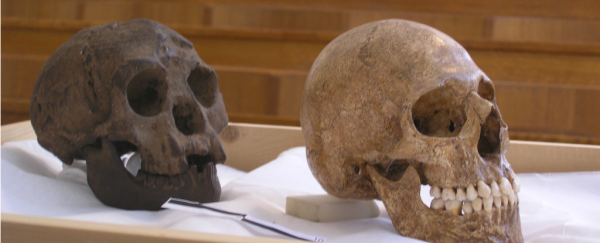This article was written by Thomas Sutikna, University of Wollongong,Matthew Tocheri, Lakehead University, and Richard 'Bert' Roberts, University of Wollongong, and was originally published by The Conversation.
New discoveries at the Indonesian cave site of Liang Bua are changing the way we look at the mysterious Homo floresiensis - known as 'hobbits' because of their short stature. We originally believed these hobbits disappeared around 12,000 years ago, but it appears they may have actually died out long before this, around 40,000 years earlier. Research published in Nature today shows they used the cave between 190,000 and 50,000 years ago.
The findings, by ourselves and a team of international researchers, puts the disappearance of Homo floresiensis at around the same time that modern humans (Homo sapiens) first spread through the region and reached Australia.
But whether these two species of hominin (primates more closely related to modern humans than to living apes) ever interacted, and our ancestors can be blamed for the hobbits' demise, remain open questions until direct evidence is found placing modern humans at the scene.
At present, the earliest evidence for modern humans on Flores is just 11,000 years old.
The discovery
The original discovery of Homo floresiensis was made back in September 2003, in the fading light of an archaeological excavation on the Indonesian island.
The skeletal remains of this primitive, small-brained and diminutive hominin were found buried 6 metres below the ground surface at Liang Bua, an impressive limestone cave in the island's western highlands.
In the same deposits as the remains of this new species were stone artefacts and the remains of pygmy elephant (Stegodon), giant marabou stork, vulture, and komodo dragon.
Samples of charcoal and sediment were collected for radiocarbon and luminescence dating. The resulting age estimates of just 18,000 years ago for the type specimen - i.e. the specimen that is used to name the species - of the hobbit, known as LB1, sent shock waves through the paleoanthropological community.
Fragmentary remains of other individuals were found in layers then thought to be deposited as recently as 12,000 years ago.
The tiny hominin presented us with puzzles aplenty. It has an appearance most similar to fossil human species that lived in Africa and Asia between one and three million years ago.
So how and when did this species or its ancestors get to this remote island? And how did it apparently manage to survive on Flores for 40,000 years after the first Australians had already passed through this island archipelago?
Elsewhere in the world, first contact of a native fauna with modern humans usually ends badly for the endemic animals. Not so, it seemed, with the hardy hobbits.
Further digging
The revision in the last-appearance age for Homo floresiensis is the culmination of eight further years of painstaking excavation and study of the cave deposits at Liang Bua by many of the same researchers involved in the original discovery.
 Archaeological excavations of deposits at Liang Bua. Liang Bua Team
Archaeological excavations of deposits at Liang Bua. Liang Bua TeamThe key breakthrough has been the recognition of a major break in the deposit of the sedimentary layers - a "stratigraphic unconformity" - immediately above LB1 as a result of one or more erosional events in the past.
As the excavations were extended each year, it became increasingly clear that all of the skeletal remains of Homo floresiensis, and the stone tools made by the hobbits, came from a large remnant pedestal of deposit that accumulated between 190,000 and 50,000 years ago.
At the location of LB1, the hobbit-bearing deposits are truncated by a steeply sloping surface, which is capped by sediments that accumulated only in the last 20,000 years. It was those sediments that had been inadvertently dated in the original study.
We now know that the stratigraphic sequence at Liang Bua is far more complex than had originally been thought. So, can we be confident in our new interpretation of the stratigraphy and chronology for the home of the hobbit? We think so.
By excavating more of the cave deposits in the past decade, we have added many new pieces to the jigsaw puzzle of how the site has formed. This results in a vastly improved picture of what was deposited where, when and how in the cave.
We have also used a range of new dating techniques, some of which were not available in 2003. As with technical developments in other fields of science, such as ancient DNA, time has also marched on with improvements to geochronology methods.
For example, the bones of LB1 and two other hobbits were dated using the latest uranium-series methods, while the associated sediments were dated using infrared stimulated luminescence procedures that were developed only in 2011.
These and other dating techniques, including radiocarbon, thermoluminescence, and argon dating, provide a new, more robust chronology for Liang Bua and the prehistoric hominins that used this cave in the past.
 Liang Bua, a limestone cave on the Indonesian island of Flores. Liang Bua Team
Liang Bua, a limestone cave on the Indonesian island of Flores. Liang Bua TeamWhat next for the hobbit?
There are still many chapters of hobbit history to be written.
When did the ancestors of Homo floresiensis first arrive on Flores and what did they look like? When did hobbits finally go extinct, and did modern humans play any role in their downfall?
Liang Bua still holds many secrets, but a single site can provide only a snapshot in time.
So the search is on for more hobbit sites, spanning a wider geographic area, both on Flores and elsewhere in the Indonesian archipelago. A decade from now, we hope to have found many more pieces of this prehistoric puzzle in human evolution.
Thomas Sutikna, PhD candidate in archaeological science, University of Wollongong, Matthew Tocheri, Canada Research Chair in Human Origins, Lakehead University, and Richard 'Bert' Roberts, ARC Australian Laureate Fellow, University of Wollongong.![]()
This article was originally published by The Conversation. Read the original article.
